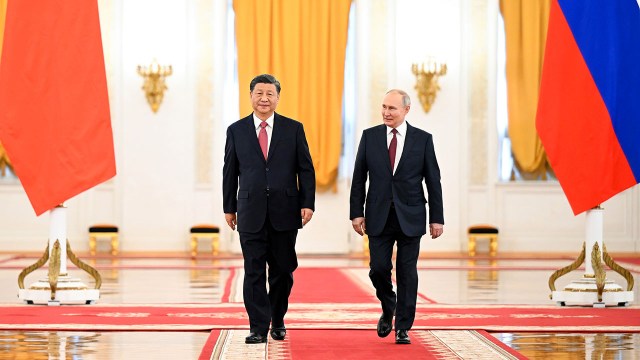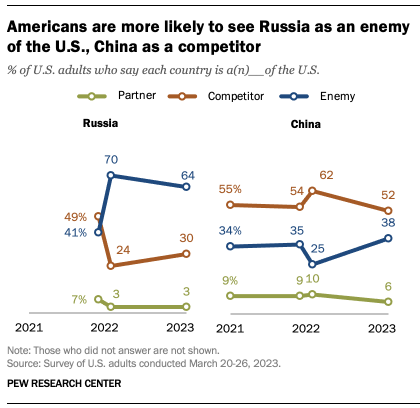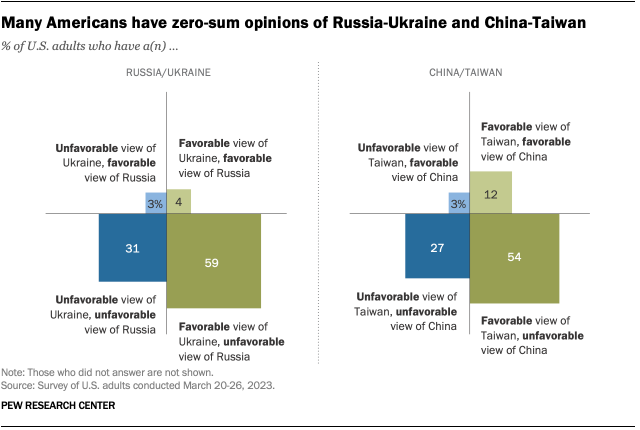
The vast majority of Americans have unfavorable views of Russia (91%) and China (83%), according to a Pew Research Center survey conducted March 20-26, 2023. That includes roughly six-in-ten (62%) who have very unfavorable views of Russia and more than four-in-ten (44%) who have very unfavorable views of China.

The leadership of both countries also instills little confidence in Americans: 90% say they have little or no confidence in Russian President Vladimir Putin to do what’s right regarding world affairs, including 71% who have no confidence in him at all. Around three-quarters of Americans (77%) also have little or no confidence in Chinese President Xi Jinping, including around half (47%) who say they have no confidence in him at all.
There are partisan differences in Americans’ views of both leaders. Democrats and independents who lean toward the Democratic Party are more likely than Republicans and Republican-leaning independents to say they have no confidence at all in Putin (77% vs. 67%). The opposite is true for Xi: 57% of Republicans have no confidence at all in him, compared with 40% of Democrats.
Pew Research Center conducted this study to gauge Americans’ views of China and Russia. For this analysis, we surveyed 3,576 U.S. adults from March 20 to 26, 2023. Everyone who took part in this survey is a member of the Center’s American Trends Panel (ATP), an online survey panel that is recruited through national, random sampling of residential addresses. This way, nearly all U.S. adults have a chance of selection. The survey is weighted to be representative of the U.S. adult population by gender, race, ethnicity, partisan affiliation, education and other categories. Read more about the ATP’s methodology.
Here are the questions on U.S. views of China and views on Russia used in this analysis, along with responses, and its methodology.
Researchers also included quotations from four focus groups held in Arlington, Virginia, in December 2022. These focus groups were part of a cross-national project that focused on how young people (ages 18 to 29) think about international engagement and multilateralism. The groups were organized by individuals’ ideological affiliation (liberal or conservative) and views toward U.S. involvement in world affairs (“internationally engaged” or “domestically focused”). Read more about the methodology for the focus groups.
Quotations from focus group participants are not necessarily representative of the majority opinion of any particular group or of the United States as a whole. Quotations may have been edited for grammar, spelling and clarity.
Americans’ views of both countries have declined markedly over the past decade. In the case of Russia, the decline in favorability followed Russia’s 2014 annexation of Crimea, while negative views of China have increased alongside the U.S.-China trade war; the outbreak of COVID-19 in Wuhan, China, in late 2019; and concerns about China’s human rights policies.
The ties between China and Russia are also a key concern for Americans, particularly amid the war in Ukraine. In March, in the wake of a meeting between Xi and Putin, 62% of Americans said the partnership between China and Russia is a very serious problem for the United States – more than said the same about any other issue in the U.S.-China relationship, including tensions between mainland China and Taiwan, China’s policies on human rights, and more.
More Americans describe Russia than China as an enemy of the U.S.
Americans differentiate between China and Russia in how they think of each country.

Nearly two-thirds of Americans (64%) see Russia as an enemy of the U.S. Three-in-ten see it as a competitor and 3% see it as a partner. In contrast, about half of U.S. adults (52%) see China as a competitor, while 38% view it as an enemy and another 6% see it as a partner.
Notably, in January 2022 – before the Russian invasion of Ukraine – somewhat similar shares of Americans saw Russia (41%) and China (35%) as enemies of the U.S. But by March 2022, after the war began, the share of Americans who saw Russia as an enemy had climbed to 70%, while the share who saw China as an enemy (25%) had fallen somewhat.
More than a year into the war, there has been little change in the share of Americans who see Russia as an enemy, while perceptions of China as an enemy have rebounded to levels seen before Russia’s invasion of Ukraine.
U.S. attitudes about Russia-Ukraine and China-Taiwan tensions
Pew Research Center also conducted focus groups in December 2022 with U.S. adults ages 18 to 29 to ask them about various international issues. In those groups, participants regularly drew parallels between Russia’s treatment of Ukraine and China’s treatment of Taiwan.
For example, one liberal man stressed how important America’s current role in supporting Ukraine is, not only for Ukraine, but also because “China is paying attention to this and thinking about what is going to happen when it invades Taiwan.” He argued – and most focus group participants agreed – that the “world becomes a much more dangerous place” if China invades Taiwan or if Russia wins in Ukraine, and he stressed that the U.S. needs to counter both powers.
A conservative man similarly emphasized the importance of the U.S. working multilaterally and “getting everyone on the same page.” He said that countries must counter China “swallowing up countries or building up islands” to prevent broader conflict, as in Russia’s annexation of Crimea.
While the March survey did not ask Americans to compare how Russia and China are treating other countries, Americans express much more favorable views of Ukraine than Russia (64% vs. 7%) and Taiwan than China (65% vs. 14%). And views of each conflict are largely zero-sum: A majority of Americans (59%) have favorable views of Ukraine and unfavorable views of Russia, and a similar share (54%) have favorable views of Taiwan and unfavorable views of China.

Older Americans are more likely than younger Americans to have these zero-sum opinions of Ukraine and Russia, as well as Taiwan and China. The same is true of people with higher levels of education compared with those with less education.
The pattern differs somewhat by party, however. Democrats and Republicans are about equally as likely to have positive views of Taiwan and negative views of China (56% vs. 56%). Yet Democrats are much more likely than Republicans to have favorable views of Ukraine and unfavorable views of Russia (73% vs. 48%).
Note: Here are the questions on U.S. views of China and views on Russia used in this analysis, along with responses, and its methodology.





